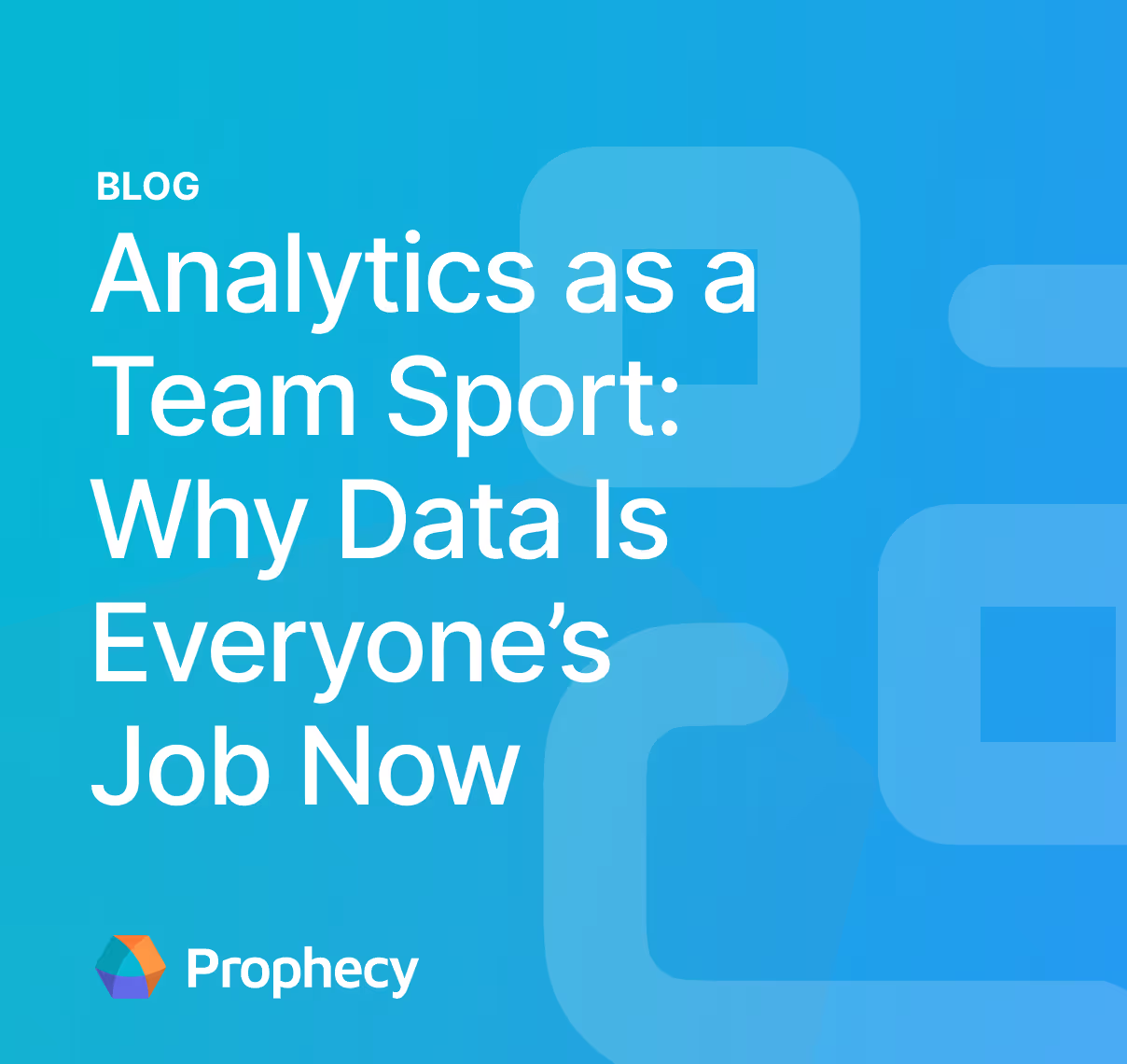12 Reasons Your Analytics Strategy is Failing as a Team Sport
Discover how analytics strategies fail from issues like siloed data, shadow IT, weak governance, and lack of collaboration.
Today, many leading organizations view analytics as a team sport, where success depends on collaboration and alignment among all players—whether they are business users, data engineers, or analysts. When everyone works together towards a common goal, great things happen. But when things aren’t in sync, it leads to confusion, delays, and missed opportunities.
Just like in sports, there are common issues that can derail your analytics strategy—miscommunication, misaligned goals, and lack of coordination. Identifying and fixing these problems can significantly improve your organization’s ability to make data-driven decisions, drive better results, and ultimately work more efficiently.
1. Siloed data and tribal knowledge
Data silos are a pervasive problem that occurs when different departments or teams manage their own separate datasets and analytics tools without sharing them across the organization. This leads to fragmented insights, inefficiencies, and duplication of effort. Additionally, tribal knowledge—the critical insights that exist only in people’s heads—further complicates the situation. Without a centralized way to share insights, your organization may miss out on the full value of its data.
To address this, you can:
- Centralize your data into a unified platform that all departments can access.
- Encourage cross-functional collaboration and provide training to ensure everyone can access and interpret the data.
- Foster a culture of knowledge-sharing and transparency, breaking down the silos that hinder productivity.
2. Inadequate data-sharing practices
Effective data sharing is essential for unlocking the full potential of analytics. But in many organizations, sharing data is far from straightforward. Data is often stored in multiple systems, or the process for sharing it is complicated and slow. This results in issues that delay decision-making and limit the value that teams can extract from their data. Additionally, inefficient or unclear data-sharing practices can cause departments to duplicate their efforts and work with outdated or incomplete data.
To address this, you can:
- Invest in tools that simplify data sharing and ensure secure access across the organization.
- Set clear guidelines on how to handle and share data securely.
- Develop a centralized data hub where teams can easily access the latest data.
3. Weak or overbearing governance
Finding the right balance between governance and flexibility is key to a successful analytics strategy. When data governance is weak, your organization may face security risks, compliance violations, and poor data quality. On the other hand, overly strict or cumbersome governance processes can slow down data access and analytics, creating bottlenecks and frustration. A balanced approach is crucial to ensuring data security without hindering productivity.
To address this, you can:
- Implement a governance framework that ensures data security and compliance without hindering workflow.
- Automate quality checks and compliance rules to reduce manual oversight.
- Regularly review governance practices to ensure they are aligned with both business needs and regulatory requirements.
4. Inconsistent metrics and definitions
Inconsistent metrics and definitions are often at the root of analytics issues. Different teams using different definitions for key metrics can lead to conflicting data insights, which complicates analysis and decision-making. This inconsistency creates confusion, especially when business teams across departments work off different sets of numbers. When everyone isn’t aligned on what the data means or how it’s measured, it’s nearly impossible to trust analytics results.
To address this, you can:
- Develop a centralized data dictionary that clearly defines metrics and KPIs for all teams.
- Create a standardized process for measuring and reporting key data points.
- Regularly audit and update metrics to ensure consistency across teams.
5. Bottlenecked data engineering
When data engineers are overwhelmed with repetitive tasks, such as fulfilling ad-hoc requests or performing redundant data transformations, it leads to bottlenecks. This slows down data delivery and prevents engineers from focusing on higher-value work like improving data pipelines or developing new capabilities. Data engineers become a bottleneck rather than the enablers of strategic decision-making. This frustration can lead to burnout and missed business opportunities due to delays in data delivery.
To address this, you can:
- Automate repetitive data engineering tasks to free up time for higher-value work.
- Invest in self-service data tools that allow business teams to handle their own data needs.
- Align data engineering efforts with strategic initiatives, rather than purely transactional requests.
6. Shadow IT and tool sprawl
Shadow IT refers to the unauthorized use of tools or systems that employees adopt to work around delays or limitations in official IT systems. While shadow IT might offer short-term solutions, it often creates long-term problems such as security vulnerabilities, inconsistent data, and integration challenges. Additionally, tool sprawl—when multiple teams use different analytics tools—can increase complexity, causing unnecessary inefficiencies and making it harder to manage data across the organization.
To address this, you can:
- Establish a centralized tool strategy and ensure all tools meet the company’s security and compliance standards.
- Provide employees with the necessary tools and establish clear guidelines for their use.
- Monitor tool usage regularly to avoid unauthorized or non-compliant tools creeping in.
7. Cultural resistance to data-driven decisions
A data-driven culture is key to success, but not all employees are ready to embrace it. Some might resist using data for decision-making because they are accustomed to making decisions based on experience or intuition. Others may lack confidence in their ability to analyze data or may find it intimidating. Additionally, some employees may be resistant because they've been burned by unreliable data in the past and aren't confident that the effort is worth it.
This resistance can prevent an organization from fully utilizing its analytics potential and making data-driven decisions more quickly and accurately.
To address this, you can:
- Promote a data-driven culture by showcasing successful case studies and results.
- Provide training and support to help employees understand the value of data in decision-making.
- Encourage leadership to model data-driven behavior by using data in their decision-making processes.
8. Dashboard overload and lack of context
Analytics dashboards can become overwhelming when they are overloaded with too many metrics and lack context. Dashboards are supposed to help you make decisions, but in many organizations, they've become information dumps with no clear focus. This can lead to confusion and misinterpretation of data, making it harder for employees to derive actionable insights. The lack of context further compounds this issue, as users struggle to understand how to use the data to inform their decisions.
To address this, you can:
- Design dashboards with a clear, focused purpose, ensuring each metric serves a specific goal.
- Provide context for each data point and include actionable insights to guide decision-making.
- Regularly review dashboards to ensure they remain relevant and easy to understand.
9. Analytics not embedded in workflows
Analytics must be integrated into daily workflows to be truly effective. When analytics tools like dashboards are separate from the tools and systems employees use every day, they become an afterthought. Employees may not engage with them regularly, leading to missed opportunities for data-driven decisions. Without seamless integration, data insights are delayed, and organizations are unable to make real-time decisions based on the latest data.
To address this, you can:
- Embed analytics tools into daily workflows and business applications so data is available where and when it's needed.
- Use automation to deliver insights directly to employees as part of their routine tasks.
- Align analytics goals with departmental objectives to ensure that data is being used to drive business outcomes.
10. Poor change management and training
Introducing new tools or systems without proper change management or training leads to low adoption and poor outcomes. Employees may struggle to use new systems if they don’t receive adequate training or if the change is poorly communicated. This results in frustration, lower productivity, and a failure to capitalize on the benefits of new analytics tools. Without proper support and guidance, teams may revert to old ways of working, preventing the organization from realizing the full potential of its data.
To address this, you can:
- Implement a comprehensive change management strategy that includes clear communication and stakeholder involvement.
- Provide training and resources to help employees get up to speed with new tools.
- Foster a feedback loop so employees can voice concerns and provide input during the rollout of new tools.
11. Misaligned incentives and accountability
When incentives are not aligned with the use of data, teams may not prioritize analytics, and the strategy can falter. Additionally, individuals or teams who aren’t held accountable for their use of data can easily fall into a cycle of inefficiency. This misalignment often leads to suboptimal data usage and a lack of ownership over data-driven decisions, which limits the effectiveness of the analytics strategy.
To address this, you can:
- Align incentives with data-driven goals by making analytics a key part of performance metrics.
- Ensure that all teams understand how their work impacts overall business outcomes and the role of data in that.
- Create a clear accountability framework to track progress and ensure that analytics initiatives are contributing to strategic objectives.
12. Lack of executive sponsorship
Data-driven decision-making is still a relatively new concept for many organizations. In some cases, senior leadership may not fully understand the potential of data or the role it plays in driving business outcomes. Without executive buy-in, data initiatives often struggle to gain the necessary resources and organizational support. Executives who don’t recognize the value of data analytics may also poorly prioritize data-related projects. This lack of direction can hamper the success of data-driven efforts across the organization.
To address this, you can:
- Secure executive sponsorship by demonstrating the ROI of data-driven decisions.
- Make the case that investing in analytics will help the business become more agile and competitive.
- Engage executives in the development of the data strategy to ensure alignment with business goals.
Transform your analytics from a solo struggle into a winning team effort with Prophecy
Prophecy solves the fundamental collaboration problem that plagues most analytics teams. Instead of forcing business users to wait weeks for data engineers or letting ungoverned self-service create compliance nightmares, our platform creates a shared workspace where everyone can contribute their expertise while maintaining enterprise-grade security and governance.
Here's how Prophecy enables true team-based analytics:
- Visual-code dual interface: Your data engineers work in code while business analysts use drag-and-drop visual tools—both editing the same pipelines in real time. No more translation errors or miscommunication about requirements, because everyone is literally working on the same project with their preferred interface.
- Intuitive AI agent: Business users can describe what they need in plain English, and the AI agent translates it into working data transformations. Meanwhile, technical users get intelligent suggestions for optimizations and automated test generation, making the entire team more productive without sacrificing quality.
- Built-in governance and collaboration: Role-based access controls integrate seamlessly with your existing security systems like Unity Catalog, while Git integration enables proper version control and collaborative development. Your business users get self-service capabilities within guardrails that keep IT and compliance teams happy.
- Real-time shared workspaces: Team members can add comments, annotations, and work simultaneously on data pipelines. When business requirements change, everyone sees the updates immediately, eliminating the back-and-forth that typically derails analytics projects.
Find out more about how to overcome the obstacles data teams face to ensure their success in our ebook, Five Dysfunctions of a Data Team.
Ready to give Prophecy a try?
You can create a free account and get full access to all features for 21 days. No credit card needed. Want more of a guided experience? Request a demo and we’ll walk you through how Prophecy can empower your entire data team with low-code ETL today.
Ready to see Prophecy in action?
Request a demo and we’ll walk you through how Prophecy’s AI-powered visual data pipelines and high-quality open source code empowers everyone to speed data transformation
Get started with the Low-code Data Transformation Platform
Meet with us at Gartner Data & Analytics Summit in Orlando March 11-13th. Schedule a live 1:1 demo at booth #600 with our team of low-code experts. Request a demo here.
Related content
A generative AI platform for private enterprise data
Introducing Prophecy Generative AI Platform and Data Copilot
Ready to start a free trial?
Lastest posts

The Future of Data Is Agentic: Key Insights from Our CDO Magazine Webinar

Analytics as a Team Sport: Why Data Is Everyone’s Job Now




